This is a fixed-text formatted version of a Jupyter notebook
- Try online
- You can contribute with your own notebooks in this GitHub repository.
- Source files: spectrum_simulation.ipynb | spectrum_simulation.py
Spectrum simulation for CTA¶
A quick example how to use the functions and classes in gammapy.spectrum in order to simulate and fit spectra.
We will simulate observations for the Cherenkov Telescope Array (CTA) first using a power law model without any background. Than we will add a power law shaped background component. The next part of the tutorial shows how to use user defined models for simulations and fitting.
We will use the following classes:
- gammapy.spectrum.SpectrumDatasetOnOff
- gammapy.spectrum.SpectrumDataset
- gammapy.irf.load_cta_irfs
- gammapy.modeling.models.PowerLawSpectralModel
Setup¶
Same procedure as in every script …
[1]:
%matplotlib inline
import matplotlib.pyplot as plt
[2]:
import numpy as np
import astropy.units as u
from gammapy.spectrum import (
SpectrumDatasetOnOff,
CountsSpectrum,
SpectrumDataset,
)
from gammapy.modeling import Fit, Parameter
from gammapy.modeling.models import PowerLawSpectralModel, SpectralModel
from gammapy.irf import load_cta_irfs
Simulation of a single spectrum¶
To do a simulation, we need to define the observational parameters like the livetime, the offset, the assumed integration radius, the energy range to perform the simulation for and the choice of spectral model. This will then be convolved with the IRFs, and Poission fluctuated, to get the simulated counts for each observation.
[3]:
# Define simulation parameters parameters
livetime = 1 * u.h
offset = 0.5 * u.deg
integration_radius = 0.1 * u.deg
# Energy from 0.1 to 100 TeV with 10 bins/decade
energy = np.logspace(-1, 2, 31) * u.TeV
solid_angle = 2 * np.pi * (1 - np.cos(integration_radius)) * u.sr
[4]:
# Define spectral model - a simple Power Law in this case
model_ref = PowerLawSpectralModel(
index=3.0,
amplitude=2.5e-12 * u.Unit("cm-2 s-1 TeV-1"),
reference=1 * u.TeV,
)
print(model_ref)
PowerLawSpectralModel
Parameters:
name value error unit min max frozen
--------- --------- ----- -------------- --- --- ------
index 3.000e+00 nan nan nan False
amplitude 2.500e-12 nan cm-2 s-1 TeV-1 nan nan False
reference 1.000e+00 nan TeV nan nan True
Get and set the model parameters after initialising¶
The model parameters are stored in the Parameters object on the spectal model. Each model parameter is a Parameter instance. It has a value and a unit attribute, as well as a quantity property for convenience.
[5]:
print(model_ref.parameters)
Parameters
index : 3.000
amplitude : 2.50e-12 1 / (cm2 s TeV)
reference (frozen) : 1.000 TeV
[6]:
print(model_ref.parameters["index"])
model_ref.parameters["index"].value = 2.1
print(model_ref.parameters["index"])
Parameter(name='index', value=3.0, factor=3.0, scale=1.0, unit=Unit(dimensionless), min=nan, max=nan, frozen=False)
Parameter(name='index', value=2.1, factor=2.1, scale=1.0, unit=Unit(dimensionless), min=nan, max=nan, frozen=False)
[7]:
# Load IRFs
filename = (
"$GAMMAPY_DATA/cta-1dc/caldb/data/cta/1dc/bcf/South_z20_50h/irf_file.fits"
)
cta_irf = load_cta_irfs(filename)
A quick look into the effective area and energy dispersion:
[8]:
aeff = cta_irf["aeff"].to_effective_area_table(offset=offset, energy=energy)
aeff.plot()
plt.loglog()
print(cta_irf["aeff"].data)
NDDataArray summary info
MapAxis
name : energy
unit : 'TeV'
nbins : 42
node type : edges
edges min : 1.3e-02 TeV
edges max : 2.0e+02 TeV
interp : log
MapAxis
name : offset
unit : 'deg'
nbins : 6
node type : edges
edges min : 0.0e+00 deg
edges max : 6.0e+00 deg
interp : lin
Data : size = 252, min = 0.000 m2, max = 5371581.000 m2
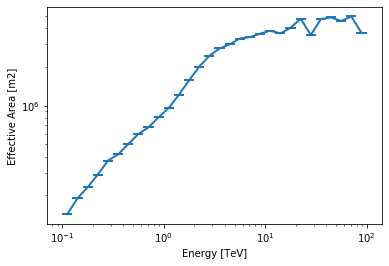
[9]:
edisp = cta_irf["edisp"].to_energy_dispersion(
offset=offset, e_true=energy, e_reco=energy
)
edisp.plot_matrix()
print(edisp.data)
/Users/adonath/github/adonath/gammapy/gammapy/utils/interpolation.py:159: Warning: Interpolated values reached float32 precision limit
"Interpolated values reached float32 precision limit", Warning
NDDataArray summary info
MapAxis
name : e_true
unit : 'TeV'
nbins : 30
node type : edges
edges min : 1.0e-01 TeV
edges max : 1.0e+02 TeV
interp : log
MapAxis
name : e_reco
unit : 'TeV'
nbins : 30
node type : edges
edges min : 1.0e-01 TeV
edges max : 1.0e+02 TeV
interp : log
Data : size = 900, min = 0.000, max = 0.926
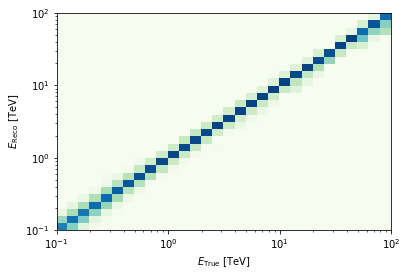
[10]:
dataset = SpectrumDataset(
aeff=aeff, edisp=edisp, model=model_ref, livetime=livetime, name="obs-0"
)
dataset.fake(random_state=42)
[11]:
# Take a quick look at the simulated counts
dataset.counts.plot()
[11]:
<matplotlib.axes._subplots.AxesSubplot at 0x1245339e8>
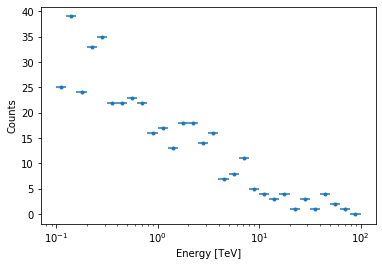
Include Background¶
In this section we will include a background component extracted from the IRF. Furthermore, we will also simulate more than one observation and fit each one individually in order to get average fit results.
[12]:
# We assume a PowerLawSpectralModel shape of the background as well
bkg_data = (
cta_irf["bkg"].evaluate_integrate(
fov_lon=0 * u.deg, fov_lat=offset, energy_reco=energy
)
* solid_angle
* livetime
)
bkg = CountsSpectrum(
energy[:-1], energy[1:], data=bkg_data.to_value(""), unit=""
)
[13]:
dataset = SpectrumDatasetOnOff(
aeff=aeff,
edisp=edisp,
model=model_ref,
livetime=livetime,
acceptance=1,
acceptance_off=5,
)
[14]:
%%time
# Now simulate 30 indepenent spectra using the same set of observation conditions.
n_obs = 100
seeds = np.arange(n_obs)
datasets = []
for idx in range(n_obs):
dataset.fake(random_state=idx, background_model=bkg)
datasets.append(dataset.copy())
CPU times: user 184 ms, sys: 3.48 ms, total: 188 ms
Wall time: 188 ms
Before moving on to the fit let’s have a look at the simulated observations.
[15]:
n_on = [dataset.counts.data.sum() for dataset in datasets]
n_off = [dataset.counts_off.data.sum() for dataset in datasets]
excess = [dataset.excess.data.sum() for dataset in datasets]
fix, axes = plt.subplots(1, 3, figsize=(12, 4))
axes[0].hist(n_on)
axes[0].set_xlabel("n_on")
axes[1].hist(n_off)
axes[1].set_xlabel("n_off")
axes[2].hist(excess)
axes[2].set_xlabel("excess");
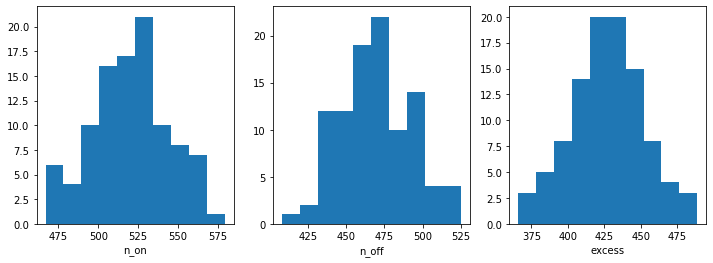
Now, we fit each simulated spectrum individually
[16]:
%%time
results = []
for dataset in datasets:
dataset.model = model_ref.copy()
fit = Fit([dataset])
result = fit.optimize()
results.append(
{
"index": result.parameters["index"].value,
"amplitude": result.parameters["amplitude"].value,
}
)
CPU times: user 3.38 s, sys: 19.3 ms, total: 3.39 s
Wall time: 3.41 s
We take a look at the distribution of the fitted indices. This matches very well with the spectrum that we initially injected, index=2.1
[17]:
index = np.array([_["index"] for _ in results])
plt.hist(index, bins=10, alpha=0.5)
plt.axvline(x=model_ref.parameters["index"].value, color="red")
print("spectral index: {:.2f} +/- {:.2f}".format(index.mean(), index.std()))
spectral index: 2.10 +/- 0.04
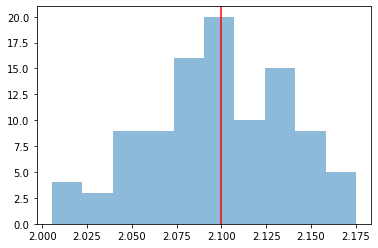
Adding a user defined model¶
Many spectral models in gammapy are subclasses of SpectralModel. The list of available models is shown below.
[18]:
SpectralModel.__subclasses__()
[18]:
[gammapy.modeling.models.spectral.ConstantSpectralModel,
gammapy.modeling.models.spectral.CompoundSpectralModel,
gammapy.modeling.models.spectral.PowerLawSpectralModel,
gammapy.modeling.models.spectral.PowerLaw2SpectralModel,
gammapy.modeling.models.spectral.ExpCutoffPowerLawSpectralModel,
gammapy.modeling.models.spectral.ExpCutoffPowerLaw3FGLSpectralModel,
gammapy.modeling.models.spectral.SuperExpCutoffPowerLaw3FGLSpectralModel,
gammapy.modeling.models.spectral.SuperExpCutoffPowerLaw4FGLSpectralModel,
gammapy.modeling.models.spectral.LogParabolaSpectralModel,
gammapy.modeling.models.spectral.TemplateSpectralModel,
gammapy.modeling.models.spectral.ScaleSpectralModel,
gammapy.modeling.models.spectral.AbsorbedSpectralModel,
gammapy.modeling.models.spectral.NaimaSpectralModel,
gammapy.modeling.models.spectral.GaussianSpectralModel,
gammapy.modeling.models.spectral.LogGaussianSpectralModel,
gammapy.modeling.models.spectral_crab.MeyerCrabSpectralModel]
This section shows how to add a user defined spectral model.
To do that you need to subclass SpectralModel. All SpectralModel subclasses need to have an __init__ function, which sets up the Parameters of the model and a static function called evaluate where the mathematical expression for the model is defined.
As an example we will use a PowerLawSpectralModel plus a Gaussian (with fixed width).
[19]:
class UserModel(SpectralModel):
def __init__(self, index, amplitude, reference, mean, width):
super().__init__(
[
Parameter("index", index, min=0),
Parameter("amplitude", amplitude, min=0),
Parameter("reference", reference, frozen=True),
Parameter("mean", mean, min=0),
Parameter("width", width, min=0, frozen=True),
]
)
@staticmethod
def evaluate(energy, index, amplitude, reference, mean, width):
pwl = PowerLawSpectralModel.evaluate(
energy=energy,
index=index,
amplitude=amplitude,
reference=reference,
)
gauss = amplitude * np.exp(-(energy - mean) ** 2 / (2 * width ** 2))
return pwl + gauss
[20]:
model = UserModel(
index=2,
amplitude=1e-12 * u.Unit("cm-2 s-1 TeV-1"),
reference=1 * u.TeV,
mean=5 * u.TeV,
width=0.2 * u.TeV,
)
print(model)
UserModel
Parameters:
name value error unit min max frozen
--------- --------- ----- -------------- --------- --- ------
index 2.000e+00 nan 0.000e+00 nan False
amplitude 1.000e-12 nan cm-2 s-1 TeV-1 0.000e+00 nan False
reference 1.000e+00 nan TeV nan nan True
mean 5.000e+00 nan TeV 0.000e+00 nan False
width 2.000e-01 nan TeV 0.000e+00 nan True
[21]:
energy_range = [1, 10] * u.TeV
model.plot(energy_range=energy_range);
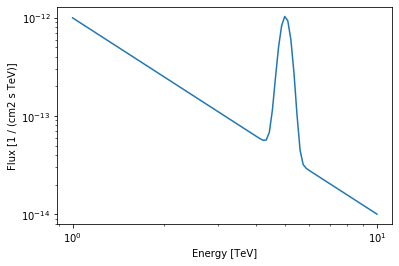
Exercises¶
- Change the observation time to something longer or shorter. Does the observation and spectrum results change as you expected?
- Change the spectral model, e.g. add a cutoff at 5 TeV, or put a steep-spectrum source with spectral index of 4.0
- Simulate spectra with the spectral model we just defined. How much observation duration do you need to get back the injected parameters?
What next?¶
In this tutorial we simulated and analysed the spectrum of source using CTA prod 2 IRFs.
If you’d like to go further, please see the other tutorial notebooks.